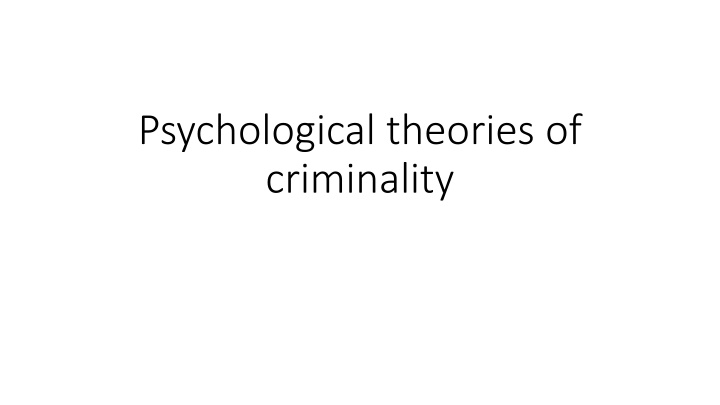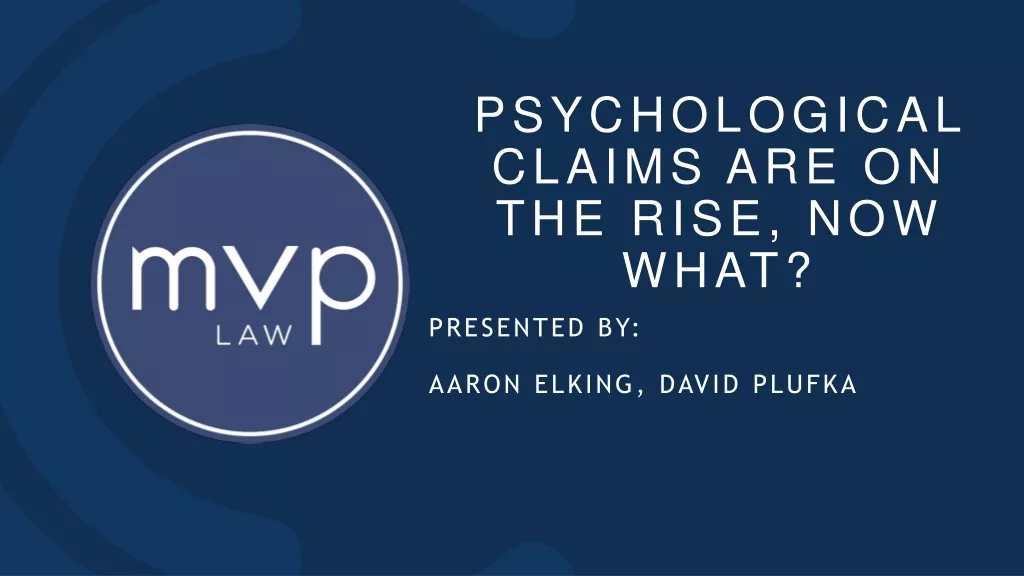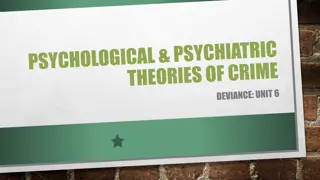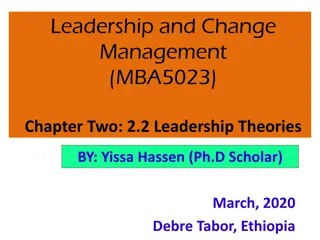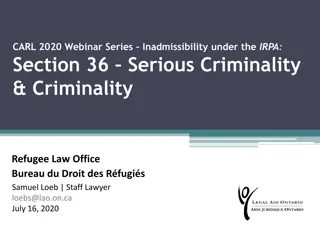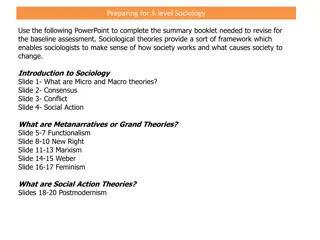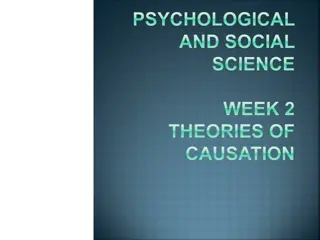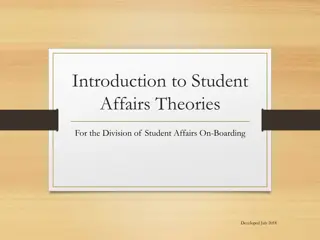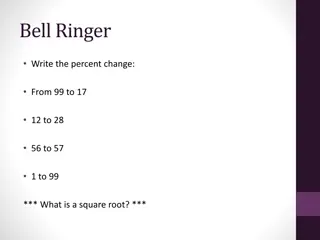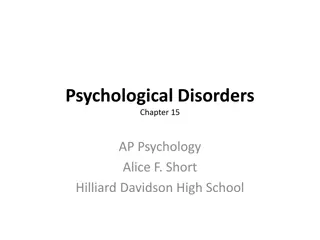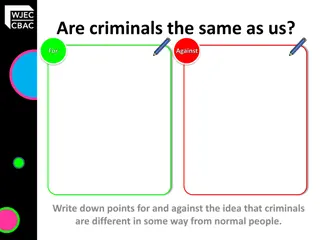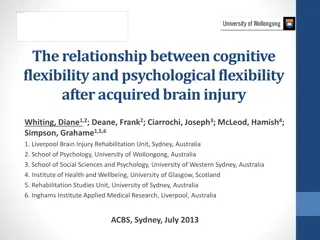Psychological Theories of Criminality: Understanding the Roots
Psychological theories of criminality delve into the association between intelligence, personality, learning, and criminal behavior. Major theories include Psychodynamic Theory by Freud, Behavioral Theory by Bandura, and Cognitive Theory by Kohlberg. These theories explore how unconscious mental processes, socialization factors, and learning experiences impact an individual's propensity towards criminal acts. While Psychodynamic Theory focuses on childhood influences and internal conflicts, Behavioral Theory emphasizes behaviorism and social learning. Understanding these theories sheds light on the complex nature of criminal behavior.
Download Presentation

Please find below an Image/Link to download the presentation.
The content on the website is provided AS IS for your information and personal use only. It may not be sold, licensed, or shared on other websites without obtaining consent from the author.If you encounter any issues during the download, it is possible that the publisher has removed the file from their server.
You are allowed to download the files provided on this website for personal or commercial use, subject to the condition that they are used lawfully. All files are the property of their respective owners.
The content on the website is provided AS IS for your information and personal use only. It may not be sold, licensed, or shared on other websites without obtaining consent from the author.
E N D
Presentation Transcript
Psychological theories of criminality
normal personalities, normal individuals vs abnormal individuals Psychological theories focus on association among intelligence, personality, learning and criminal behaviour (activity) Three major theories: 1) Psychodynamic theory (Freud, Aichorn) 2) Behavioral theory (Bandura) 3) Cognitive theory (Kohlberg) + personality and intelligence There is not only one reason why a person commits crime
I. Psychodynamic theory an individual s personality is controlled by unconscious mental processes that are grounded in early childhood Theory originated by Sigmunt Freud Three elements of the human personality: 1) the id, 2) the ego, 3) the superego The id represent the unconscious biological drives for food, sex, etc., it is concerned with instant pleasure or gratification; pleasure principle The ego develops early in a person s life; reality principle The superego develops when a person incorporates the moral standars and values of the community (parents, school, friends, co-workers) it is the conscience, a brake The ego mediates between the id s desire for instant gratification and the strict morality of the superego The id and a superego are often in a conflict Weak or absent ego leads to committing a crime, engaging in drug abuse, etc. displaced agression , triggered displaced agression
August Aichorn - unlike many of the sociologists of his day, Aichorn felt that exposure to stressful social environments did not automatically produce crime or violence. After all, most people are exposed to extreme stress and do not engage in serious forms of criminality. Aichorn felt that stress only produced crime in those who had a particular mental state known as latent delinquency. Latent delinquency, according to Aichorn, results from inadequate childhood socialization and manifests itself in the need for immediate gratification (impulsivity), a lack of empathy for others, and the inability to feel guilt (Aichorn, first published in 1925, reprinted 1936). He postulated that the failure to develop a superego was the results of the parents being unloving or absent for much of the child s upbringing. Parental neglect was not seen as the only reason for the super-ego to be underdeveloped: over-indulgent parents, allowing the child to do anything, would have a similar effect
II. Behavioral theory - behaviorism Human behaviour is developed thorugh learning experiences Albert Bandura (Social Learning Theory of Aggression, 1978): people change their behaviour according to reactions this behaviour elicits in other people Awards and punishments Behaviorists consider crimes as learned responses to life s situations social learning theory by Albert Bandura: children learn violence through observation of others, primarily: 1) family interaction, 2) environmental experiences, 3) mass media (also video games)
Behavioural theorists have argued that the following four factors help produce violence: 1) a stressful event or stimulus like a threat, challenge or assault that heightens arousal; 2) aggressive skills or techniques learned through observing others; 3) a belief that aggression or violence will be socially rewarded (by, for example, reducing frustration, enhancing self-esteem, providing material goods or earning the praise of other people); and 4) a value system that condones violent acts within certain social contexts. Early empirical tests of these four principles were promising (Bartol, 2002). As a result, behavioural theory directly contributed to the development of social learning theories of deviance (differential association theory, sub- cultural theory, neutralization theory, etc.).
III. Cognitive theory Mental processes of the individual Wilhelm Wundt and Willian James pioneers Two main subdisciplines: moral development and information- processing branch Lawrence Kohlberg applied the concept of moral development people pass through stages of moral development; there are levels, stages and social orientation Information-processing branch: Shelden (2006) people who use information properly are less likely to commit a crime
Personality and crime Clark, Boccaccini, Caillouet & Chaplin (2007): personality is something that makes us what we are and also that which makes us different from others Big Five model of personality (by Paul Costa and Robert McCrae): 1) Neuroticism 2) Extraversion 3) Openness 4) Agreeableness 5) Conscientiousness It is assumed that the highlighted factors: -they exist in reality (and as such they are important in adapting the individual to the environment, e.g. conscientiousness is one of the determinants of the quality of professional work and academic achievements, and is also associated with life satisfaction) -are immutable -are universal (i.e. independent of race, gender or culture) -are biologically conditioned (they have a high degree of heritability) Hostility, impulsivity and narcissism are correlated with delinquent and criminal behaviour Hans Eysenck identified two antisocial personality traits: 1) extraversion, 2) neuroticism (these are also associated with self-destructive behaviour)
Intelligence and crime Criminologists working in the early 20thcentury often argued that intelligence is strongly associated with criminal behaviour. In the 1920s, the governments of British Columbia and Alberta passed negative eugenics laws that called for the sterilization of people thought to possess low intelligence or other negative psychological characteristics . The Act of 1928 (Sexual Sterilization Act) in force in Alberta aimed to combat problems with unemployment, crime and poverty, legalizing surgical sterilization in people with mental problems, mainly among ethnic minorities Boards of Eugenics: judge, psychiatric, social worker.
The nature-versus-nurture debate The nature theory holds that intelligence is genetically determined The nurture theory holds that intellifence is determined by the quality of the social environment (especially during childhood) and is not a product of genetic inheritance. Some scholars argue that the role of nature is prevalent but is it true that the heredity determines IQ? Travis Hirschi and Michael Hindelang (1977) the IQ is a very very strong predictor of crime and violcene; the important role of school an extensive review by the American Psychological Association found only a small relationship between intelligence and criminal behaviour.
Psychological theories of aggression Problems with defining aggression A mother s slap is it an act of aggression or not? -justifying circumstance -circumstance revoking unlawfulness -discipline for educational purposes Intent is the key Early childhood changes in a child s behaviour
Narcissism Narcissism- - a a personality personality prone unstable unstableself proneto self- -esteem to anger anger and esteem and violence violencedue due to to Kohut and Kernberg Like Freud, Kohut considers narcissism to be normal at an early stage of the individual s development Kohut: the child's "I" develops and matures through interactions with others (primarily with the mother), which provide the child with the opportunity to be reflected. Empathetic parents contribute to the healthy development of a child in two ways. First, they are a mirror that shapes in it a more realistic sense of "I" (identity). Secondly, they reveal their own limitations, thanks to which - as a result of the internalization of the idealized image - a child's personal set of ideals and values is formed. the problem arises when parents are not empathic and do not provide the child with appropriate opportunities related to the processes of reflection and idealization. according to Kohut, narcissism is a "developmental fixation" in which the "I" remains exaggerated and unrealistic. Kernberg presents a different picture of the development of narcissism. In his approach, the source of narcissism is the child's reaction to cool, non-thematic parents, especially to his mother. Such an emotionally unsatisfied child feels rage towards his parents and begins to perceive them as even less satisfying his needs. In this approach, narcissism is a defense mechanism, a desperate search for shelter in this aspect of the "I" that parents value.
Konrad Lorenzs theory. Austrian zoologist and ornithologist, creator of modern ethology, Nobel laureate in physiology or medicine in 1973 [1] K. Lorenz conducted precise observations of animal behavior. In his opinion, the driving force behind the evolution of species are four instincts: sexual, hunger, aggression and escape. The aggression instinct is responsible for the appearance of aggressive behavior. He is innate because, as studies have shown, a rat raised in complete isolation, having no experience in fighting, attacks another individual when it is in its cage. According to K. Lorenz, aggressive behavior caused by the instinct of aggression is spontaneous in the sense that a certain external situation is not necessary for their manifestation. This is because the energy associated with the instinct of aggression accumulates in central nerve centers and requires discharge. Both Freud's theory and Lorenz's theory, despite the fact that these authors drew material from different sources (Z. Freud from observing patients, K. Lorenz - from observing animal behavior), show similarity - both accept the functioning of the innate instinct of aggression, both maintain that the energy of this instinct must be discharged, causing acts of aggression regardless of the external situation. Disregarding the impact of external situations on aggressive behavior is the main weakness of this theory.
Theory of frustration-aggression In 1939, John Dollard formulated a theory according to which the reason for aggressive behavior is the state of frustration. Every aggressive behavior is preceded by experiencing frustration, i.e. an unpleasant subjective state resulting from blocking the realization of some aspiration. Aggressive behavior is not the only possible response to a state of frustration, but the genesis of any such behavior is frustration. The more we pursue a goal, the greater the frustration. The amount of frustration is also determined by whether the failure that causes it is single or any of it. However, there are factors that inhibit the appearance of aggressive behavior in response to frustration (Linsky, Bachman, Straus, 1995). One of them is expecting punishment for revealing aggression. Unlike the previous theory, the genesis of aggressive behavior as per the theory of frustration is the external situation. Leonard Berkowitz slightly modified this theory. According to him, the Dollard d scheme: frustration-needs leads to aggressive behavior - is a big simplification. Frustration, according to L. Berkowitz, causes anger - an emotion specific to aggression. Anger causes a state of readiness for aggressive behavior, but this state does not lead to aggression automatically. In order for it to manifest itself, there must be perception in the situation of signals evoking aggressive behavior.
Fromms theory Erich Fromm a characteristic feature of this theory is the attempt to organize and understand all aspects of aggressive behavior. E. Fromm divides the aggressive behavior observed in people into 1) defensive aggressive behavior - biologically adaptive, to protect the vital values and lifeof the individual, 2) biologically maladaptive aggressive behavior - defined as destructiveness and cruelty. destructiveness and cruelty have nothing to do with instincts, drives or innate inclinations - they appear when the social conditions of human life prevent him from satisfying basic existential needs noteworthy in E. Fromm's theory is his conviction that aggressive behavior - both defensive and disaptive, destructive and cruelty, is caused by an external situation
The normal criminal personality The concept of the normal criminal personality individuals possses definable and dominant sets of rules which determine how they will behave in virtually any situation. Central or core personality How to define what is normal? Is something common? Is it something broadly accepted? Homosexuality, murders, etc.
Personality tests - MMPI MMPI the Minnesota Multiphasic Personality Inventory- (Adolescent) (MMPI-A) MMPI late 1930s/early 1940s MMPI 2, 1989; objective personality test consisting of 567 questions; yes, no, I do not know The test is called multiphasic because it is desgined to assess a numer of psychatric patterns or aspects at the same time. It is split into 10 clinical scales and 7 validity scales (to check whether someone tries to cheat) Scale 1 (AKA the Hypochondriasis Scale 2 (AKA the Depression Scale) .Scale 3 (AKA the Hysteria Scale) Scale 4 (AKA the Psychopathic Deviate Scale) Scale 5 (AKA the Femininity/Masculinity Scale) Scale 6 (AKA the Paranoia Scale) Scale7 (AKA the Psychasthenia Scale) Scale 8 (AKA the Schizophrenia Scale) Scale 9 (AKA the Mania Scale) Scale 10 (AKA the Social Introversion Scale) The resultant outcome is called the personality profile Scale 4 (Pd Psychopatic deviate) is one of the scales most commonly associated with problematic criminal behaviours (cynical, rejection of authority, questioning of the status quo, disregards rules, socially aggresive, selfish, amoral, asocial) Critics: Waldo and Dinitz (1967) questioned the use of the MMPI in the case of offenders, claiming it was unsurprising that they scored high on scale 4 because the test included items which were most likely to be answered differently by a criminal, for example I have never been in trouble with the law . However, most of the questions are not that much linked to criminality.
Why these personality tests attracted so much interest form the criminal justice system? self-reported criminality tests official criminality Offender profiling; What is the purpose of profiling? Can the polive ignore any suspect who does not match the profile? What is being taken into account? Offender profiling; FBI and David Canter
FBI profiling crime scene analysis One of the earliest modern systems of profiling Basically the profiler compares the behaviour of a current, unknown, offender with those of previous, know, offenders and types of offenders. FBI built up a database by collecting data from all their own officers who had investigated murders and sexual crimes, interviewing 36 serial murders Five stages of FBI s profiling strategy: 1) Profiling inputs or data assimilation 2) Pattern and questions 3) Crime assessment/crime classification 4) Criminal profile 5) Investigation Problems: the classification is rather rigid, many offenders may not fall into any one type
David Canters investigative psychology John Duffy and David Mulcahy (born 1958 & 1959) are two British rapists and serial killers who together attacked numerous women and children at railway stations in southern England during the 1980s. They are known as the "Railway Rapists" and the "Railway Killers". Canter s system is complex and based on five aspects (factors) of interaction between the offender and the victim: 1) Significance of time and place why such choice? 2) Interpersonal coherence/personal characteristics a selfish person will be selfish in the way of they offend 3) Criminal characteristics domestic and social factors impact; sexual naivety in an offence might suggest sexual inexperience in the offender 4) Criminal career. For example a skill in entering premises; breaking and entering 5) Forensic awareness
